Step-by-step guide: how to grow celery at home on a windowsill and what is needed for this
Celery is one of the most useful cultivated plants. It contains many valuable substances. Among them are vitamins of group B, E, C, PP, K, potassium, sodium, phosphorus, iron and iodine. It is not for nothing that celery was first used only as a medicine, and later it was discovered for cooking.
In winter, eating celery will help to avoid vitamin deficiency. However, in stores off-season, it is expensive and often contains harmful substances that it absorbs from fertilizers during the cultivation process. Therefore, many housewives prefer to grow its greens on their own. How to grow celery at home on a windowsill - read on.
The content of the article
Is it possible to grow celery on a windowsill
If we are talking about the greenery of the plant, then yes. Root and the stem varieties are grown outdoors or in a greenhouse.
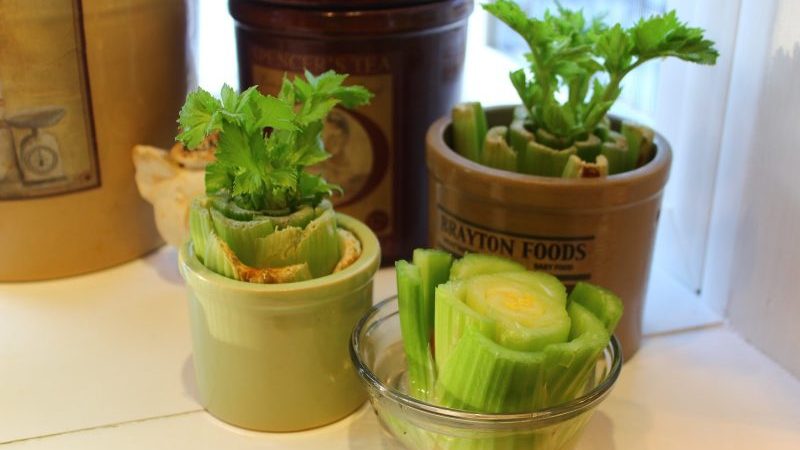
Celery is an undemanding crop. He is comfortable at room temperature. In spring and summer, it develops rapidly even without additional lighting. It is recommended to use a phytolamp in autumn.
Note! To grow leafy celery in the fall it is possible without phytolamp. In this case, the plant will develop more slowly.
Suitable varieties
When planting a root or stump, it is not necessary to consider the plant variety. In a vegetative way, you will be able to get greens in any case. Usually such planting material is purchased on the market or in a store, without even being interested in its origin.
When growing celery in an apartment from seed, the variety of the plant matters. Practice has shown that early maturing varieties grow best at home. They are considered the most unpretentious in terms of lighting and temperature. Most often, such celery has the highest immunity. Early varieties include Gentle, Vigor, Zakhar.
Preparing for landing
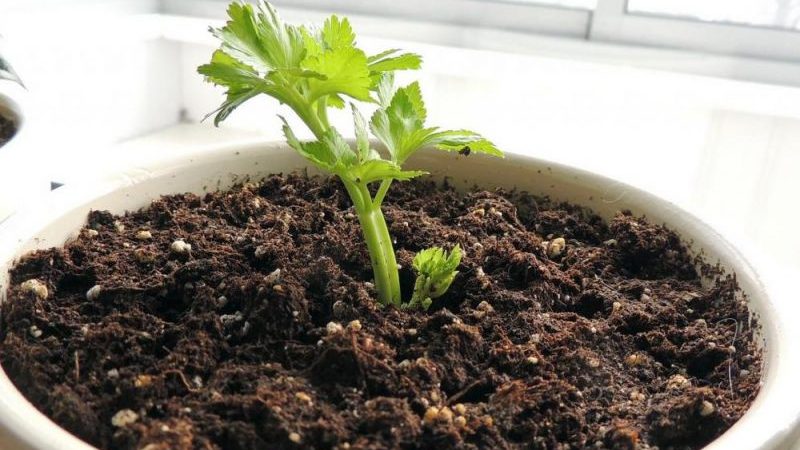
To grow celery on the windowsill, you need to create the appropriate conditions.
For celery, a universal mix is suitable seedlingswhich is sold in gardening stores. Some housewives prefer to prepare the soil mixture themselves. To do this, take:
- 2 parts of the base - garden soil;
- 1 part baking powder - crushed coconut substrate, sawdust, sand;
- 2 parts of a nutrient substrate - humus or peat.
Add 1 glass of ash to a bucket of such a mixture. The soil is disinfected in one of the following ways:
- roasting in the oven;
- watering with boiling water;
- watering with a dark pink solution of potassium permanganate;
- watering with a solution of copper sulfate (1 tbsp. l of vitriol per bucket of water);
Containers for growing celery should be wide enough, at least 15 cm deep. Special pots and containers made of any materials are suitable: mayonnaise buckets, instant noodle trays, etc.
Containers are also disinfected... They are soaked for half an hour in a dark pink solution of potassium permanganate. Wooden boxes are wiped with this solution.
In addition to containers and soil for growing celery, you will need drainage - chipped ceramics, broken brick, expanded clay, shellfish. The drainage is disinfected with a dark pink solution of potassium permanganate.
It is important to choose the right place to grow your greenery. Sills on the south or southwest side are best suited.
Planting celery in different ways
Celery is grown in three ways. Each of them has advantages and disadvantages.
From root vegetable
The fastest and easiest way. It allows you to taste the first green celery as early as 2-3 weeks after planting. But with this method of growing celery, it quickly throws out the arrow, which makes the greens unusable for use. Therefore, the harvest will only be able to be harvested once.
A root crop for growing greens is bought at the market or in a supermarket and immersed for 15 minutes in a light pink solution of potassium permanganate. After that, the planting material is ready for use.
A 5 cm layer of drainage is poured onto the bottom of a wide and deep container. The rest of the volume is filled with soil so that 3-4 cm remain free to the edge of the pot.
Celery root is planted in the ground, deepening to half. The soil is watered abundantly with warm water and placed in a warm, well-lit place.
From the stump
This method of growing celery allows for a quick harvest. Plants are easier to care for than seeds. The first greens will be ready for pruning in 3-4 weeks. The yield will be lower than in the first case. The lifespan of celery grown in this way is 3-4 months.
Petiolate celery available in supermarkets all year round. For planting, I use the stump, which remains after cutting the stems. It must be at least 3 cm long.
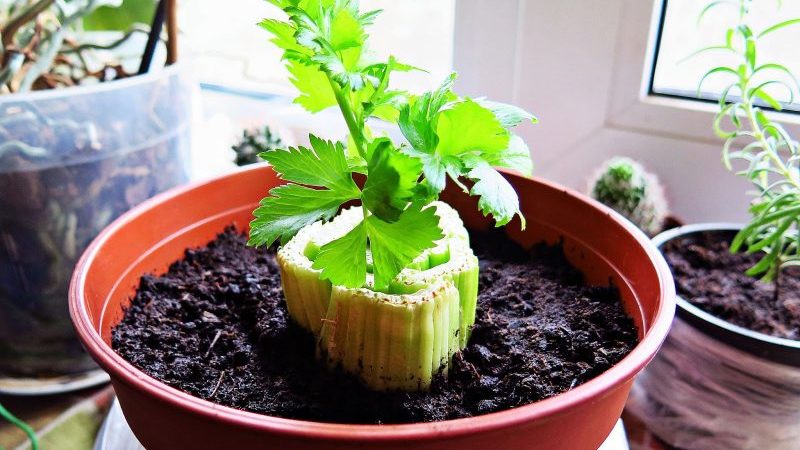 The planting material does not need preliminary processing. It is placed in a glass of water at room temperature with the stalks cut up and placed on the windowsill.
The planting material does not need preliminary processing. It is placed in a glass of water at room temperature with the stalks cut up and placed on the windowsill.
After a while, the slices on the stems will dry out and crust over. New shoots will appear on the stump. This indicates that the plant is ready to be potted.
A drainage layer is poured at the bottom of the container, and on top is soil, which should fill the pot almost to the brim. The stump is planted in the ground so that it completely, along with the dried stems, is in the ground. Only shoots should remain on the surface. After that, the earth is watered with water at room temperature.
Seeds
This is the most time consuming method of making celery greens. In this case, it will be possible to harvest the crop no earlier than in 1.5-2 months. Young plants are especially demanding for watering, temperature and lighting. The advantage of celery grown from seeds is the possibility of a long-term harvest (up to a year). After cutting off some of the leaves, new shoots quickly appear.
Celery seeds need pre-processing. It will increase their germination and reduce the risk of infection of adult plants:
- Disinfection. The planting material is immersed for 30 minutes in a light pink solution of potassium permanganate at room temperature.
- Growth stimulation... The seeds are soaked for 2 hours in aloe juice diluted with an equal amount of warm water.
It is not recommended to treat celery seeds with artificial growth stimulants. Greens accumulate substances used in their cultivation.
The container for seed celery should be wide (wooden boxes, plastic trays) and deep (about 15 cm high). At the bottom of the container, a drainage layer and earth are poured so that 2-3 cm remain unfilled to the edge.
In the ground, grooves are made with a depth of 0.5 cm at a distance of 5 cm from each other. Seeds are scattered with an interval of 1-2 cm.
The soil is moistened with warm water from a spray bottle. The boxes are covered with foil and put away in a warm place. The soil is moistened as it dries.
The first shoots will appear 12-14 days after sowing the seeds. After that, the film is removed.
Sprouted plants are thinned out. A distance of 2-3 cm on each side should remain free between them. Excess plants are not pulled out, but pinched so as not to damage the roots of neighbors.
Note! Celery seeds are sown often because they have a low germination rate.
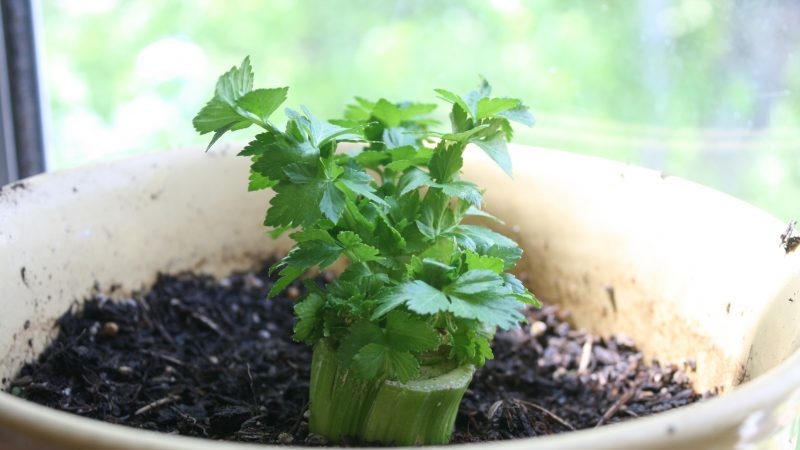
Celery care
To get a rich harvest of celery greens, it is important not only to plant it correctly, but also to provide care.
Basic principles of agricultural technology:
- Temperature. The optimum temperature for celery is + 18 ... + 22 ° C.
- Lighting. In spring and summer, the plant can grow on a windowsill without additional lighting. In winter and late autumn, it is recommended to use a phytolamp for 2-4 hours a day, exposed at a distance of 30-45 cm from the culture.
- Watering. Pour celery with settled water at room temperature. In summer, this is done once every 2-3 days, in winter, watering is reduced to 1 time per week.
- Airing. Plants need fresh air, so the room is ventilated regardless of the season. It is important to avoid drafts.
- Loosening. The soil is loosened after each watering. This will prevent the formation of an earth crust and ensure proper air exchange. It is convenient to carry out the procedure with an ordinary fork.
- Top dressing. Vermicompost or complex mineral fertilizers are applied every 2-4 weeks. To improve the environmental friendliness of greens, instead of purchased products, silage, infusion of banana peel or diluted 1:10 chicken droppings are used. The soil is moistened before fertilization.
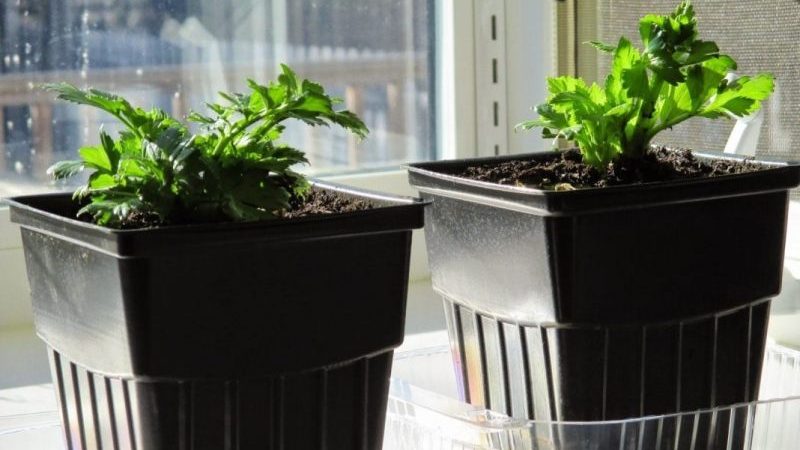
Diseases and pests
Even at home, there is a possibility of damage to celery. This happens for the following reasons:
- Neglecting disinfection. You need to disinfect soil, drainage, pots, planting material and a tool for loosening. Infections persist on them.
- Dangerous neighborhood. Diseases and pests often get on celery from nearby indoor plants.
- Drafts or lack of ventilation. This weakens the plant's immunity and increases the likelihood of infection.
- Violation of watering rules. Both dry and waterlogged soil serve as an ideal environment for the development of infections.
- Poor soil. Lack of top dressing leads to depletion of the soil in the pot and a decrease in plant immunity.
Celery is usually attacked by fungal diseases at home. These include:
- powdery mildew;
- white rot;
- septoria;
- cercosporosis.
Disease prevention refers to avoiding the factors that cause them. If the plants are sick, it makes no sense to fight infections. Treatment chemicals seep into the greens, making them hazardous to health.
There are not many pests in the apartment that can infect celery. Usually the plant is attacked by spider mites or thrips. In the fight against pests, a soap solution (1 piece of laundry soap in a bucket of water) or a decoction of bitter herbs (wormwood, dandelion, yarrow) will help. The preparations are used for spraying plants.
Not always bad plant species indicates a disease. If the celery looks lethargic, its leaves turn yellow and become stained, the reasons are looked for in the following factors:
- Violation of watering rules. The problem arises when there is a lack and excess of fluid. If the soil of a plant with signs of wilting is wet, watering will have to be stopped until it dries completely.
- Drafts. To save the plant, which is dying due to drafts, it is moved to a warm place and fed.
- Lack of nutrients. In the absence of fertilizing, the soil becomes poorer after a month.
Harvesting and storage
The harvesting method depends on the growing method... The list contains three options:
- When grown from a root crop, the crop is harvested 3 weeks after landing... Cut off all greens.
- When grown from a stalk, the first crop is harvested 4 weeks after planting. Young shoots are left, new greens will appear from them.
- Seeds. In this case, the first crop is harvested 2 months after planting. At the same time, part of the greenery is cut from each plant. This will allow new branches to develop.
It is best to collect greens as needed. If the cut celery remains unused, it is not stored in the refrigerator, but in a glass of water at room temperature.
Tips & Tricks
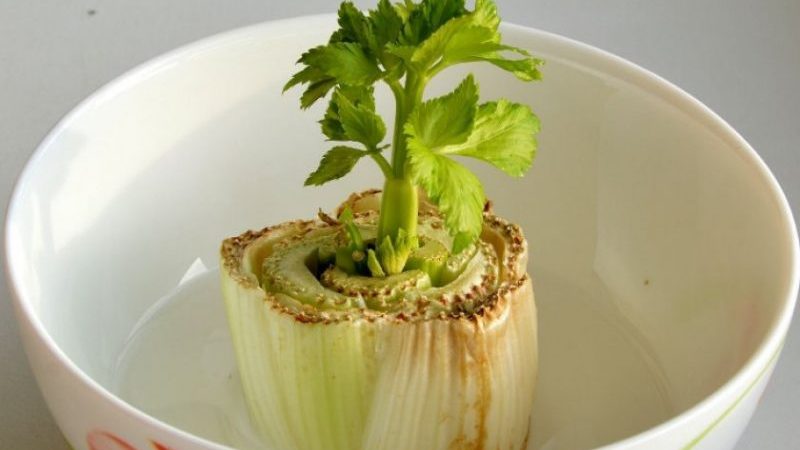
A few tips from experienced housewives will help you grow and use celery:
- Greens that are cut but unused can be frozen or dried. The taste will not deteriorate from this.
- Celery is not recommended for pregnant women. It causes an increased tone of the uterus.
- Some housewives do not water the celery, but pour a small amount of water into a saucer under the pot. The required amount of liquid is absorbed into the soil through the hole in the bottom of the pot.
- If celery was sprayed with soapy water or herbal decoction to control pests, the greens must be washed especially carefully. Otherwise, its taste will be bitter.
- To refuse from loosening the soil without consequences, the soil in pots is mulched. Peat, sawdust or straw are used as mulch.
Conclusion
Growing celery on a windowsill is a simple process that takes a little time. To get healthy greens in winter, it is not necessary to buy phytolamps and other special devices. A little patience and improvised means are enough. Even inedible cuttings of stalked celery can become planting material.
Spending quite a bit of time, you will receive not only a fragrant addition to hot dishes and salads, but also a remedy for vitamin deficiency. It is enough to eat several branches a day to prevent a decrease in immunity during the cold period.